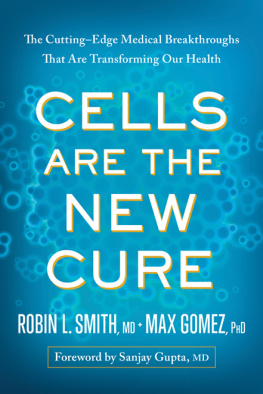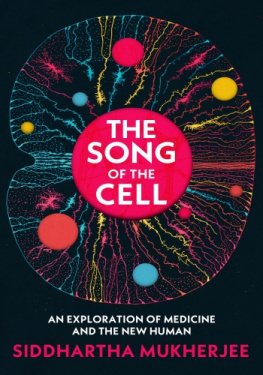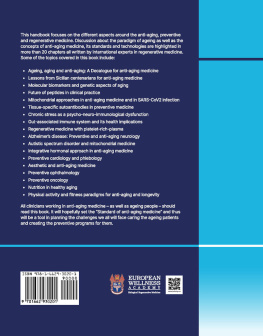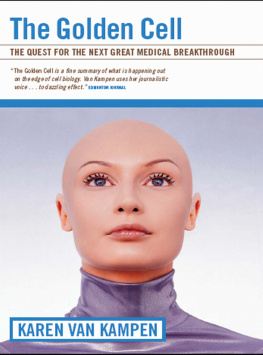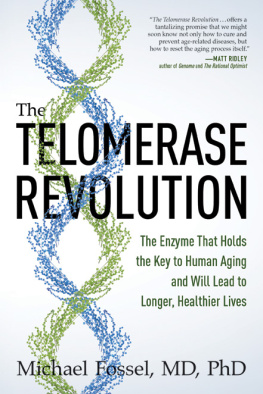PRAISE FOR
CELLS ARE THE NEW CURE
Cells Are the New Cure explains the world of cutting-edge complex scientific discovery in easy-to-understand language, interweaving the human element through stories of remission and cure. As someone who is blessed to be thriving since my stem cell transplant, this book gives us hope.
ROBIN ROBERTS,GOOD MORNING AMERICA
Cells Are the New Cure details the recent discoveries of the worlds top scientists and clinicians in the rapidly advancing field of cellular medicine. This paradigm shift in medicine will change the way we treat disease in the very near future and advances in immunotherapy will revolutionize how we approach cancer.
SEAN PARKER, PRESIDENT, PARKER FOUNDATION
Robin Smith and Max Gomez have illuminated one of the great frontiers in medicine for the general reader: The way aberrant cellular biology leads to disease and how cellular therapy can be harnessed to treat it. Cells Are the New Cure describes the many novel treatments and therapies under development and in use in the clinic and catalogues the potential of cellular therapy to alleviate untold pain and suffering across many lethal diseases like cancer and age-related degenerative conditions. They describe these historic scientific advances while compassionately relaying the real-life experiences of patients who have benefited from them.
RONALD A. DEPINHO, MD, FORMER PRESIDENT, UT MD ANDERSON CANCER CENTER
Cells Are the New Cure explores the potential in modern medicine to harness the human bodys own curative abilities to battle cancer, autoimmune diseases, and many rare diseases. Set against the backdrop of real-life stories of patients who have benefited from these therapies while they are undergoing clinical development, the book highlights that unique moment where science and life intersect.
STEPHEN C. GROFT, PHARMD., SENIOR ADVISOR TO THE DIRECTOR, NATIONAL CENTER FOR ADVANCING TRANSLATIONAL SCIENCES, AND FORMER DIRECTOR, OFFICE OF RARE DISEASES RESEARCH, NATIONAL INSTITUTES OF HEALTH
Cells Are the New Cure writes a prescription for hope, long missing from the medical care of patients like me. I have known too many dangerous conditions in my adult life. Now, science is stepping in with cutting-edge research and clinical trials that offer a bright future for those of us who have been denied a view of life beyond today.
RICHARD M. COHEN, JOURNALIST AND BESTSELLING AUTHOR WHO HAS BATTLED ILLNESSES FOR MORE THAN FORTY YEARS


Copyright 2017 by The Stem for Life Foundation
All rights reserved. No part of this book may be used or reproduced in any manner whatsoever without written permission except in the case of brief quotations embodied in critical articles or reviews.

BenBella Books, Inc.
10440 N. Central Expressway, Suite 800
Dallas, TX 75231
www.benbellabooks.com
Send feedback to
First E-Book Edition: October 2017
Library of Congress Cataloging-in-Publication Data
Names: Smith, Robin L., 1964- author. | Gomez, Max, author.
Title: Cells are the new cure : the cutting-edge medical breakthroughs that are transforming our health / Robin L. Smith and Max Gomez.
Description: Dallas, TX : BenBella Books, Inc., [2017] | Includes bibliographical references and index.
Identifiers: LCCN 2017013255 (print) | LCCN 2017014644 (ebook) | ISBN 9781944648848 (electronic) | ISBN 9781944648800 (trade cloth : alk. paper)
Subjects: | MESH: Cell- and Tissue-Based Therapy | Immunotherapy | DNA Repair | Popular Works
Classification: LCC RM370 (ebook) | LCC RM370 (print) | NLM WO 75 | DDC 615.3/7dc23
LC record available at https://lccn.loc.gov/2017013255
Editing by Glenn Yeffeth and David Bessmer | Cover design by Emily Weigel |
Copyediting by Miki Alexandra Caputo | Jacket design by Sarah Avinger |
Proofreading by Amy Zarkos and Lisa Story | Text design and composition by Aaron Edmiston |
Indexing by WordCo Indexing Services, Inc. | Printed by Versa Press |
Distributed by Perseus Distribution
www.perseusdistribution.com
To place orders through Perseus Distribution:
Tel: (800) 343-4499
Fax: (800) 351-5073
E-mail:
Special discounts for bulk sales (minimum of 25 copies) are available.
Please contact Aida Herrera at .
CONTENTS
PART ONE:
THE PROMISE OF REGENERATIVE MEDICINE
Without a doubt, stem cell research will lead to the dramatic improvement in the human condition and will benefit millions of people.
ELI BROAD
PART TWO:
OUR IMMUNE SYSTEM AS WEAPON AND HEALER
Natural forces within us are the true healers of disease.
HIPPOCRATES
PART THREE:
CHANGING OUR DNARARE DISEASES AND DESIGNER HUMANS
If we could make better humans, why shouldnt we?
JAMES WATSON, PHD
PART FOUR:
HUMAN 2.0
There are no such things as incurables. There are only things for which man has not found a cure.
BERNARD BARUCH
PART FIVE:
BIG MONEY, BIG DATA, AND THE FUTURE OF MEDICINE
The world has been very careful to pick very few diseases for eradication, because its very tough.
BILL GATES
O ne of the first stories I covered as a television reporter was the restriction on US federal funding for research on stem cells. It was August 2001, and for the next eight years, many scientists would spend more time trying to find new sources of funding than actually doing research. When the restrictions were relaxed in March 2009, there was a sense of optimism in the stem cell community but also a feeling the United States was nearly a decade behind other countries and now had to make up a lot of lost ground.
To be fair, supporters of the restrictions felt they were acting in defense of human life in protecting embryos. Furthermore, during this time several lessons were learned in the world of stem cell research that might not otherwise have been learned. First, the early data from embryonic stem cell pioneers did not prove particularly promising. Additionally, induced pluripotent stem cells (iPSCs)adult cells induced to exhibit the same properties as embryonic stem cellswere discovered. Finally, adult stem cells, thought for sixty years to reside only in bone marrow, were found in many more tissues. As we now know, this greatly opened up the range of therapeutic possibilities.
And yet, in the United States we still feel the hangover of that eight-year drought in stem cell research. Patients are understandably dubious of their true value, as too many charlatans have made laughable claims unsupported by scientific data. While the number of clinical trials has increased, the US medical system doesnt yet offer formal clinical training programs to teach stem cell therapies. My colleagues in medical journalism write with greatly tempered optimism that borders on cynicism whenever we do stories on the promise of stem cells. And at this writing, the US Food and Drug Administration has approved only one stem cell therapy product, Hemacord, to restore low blood cell counts. In fact, the FDA is sometimes stymied at how to regulate adult stem cells at all, especially when they are extracted from and then injected back into the same human body. It seems that adult stem cells dont fall neatly into the definition of device or drug, the two categories on which the FDA focuses.
Next page
